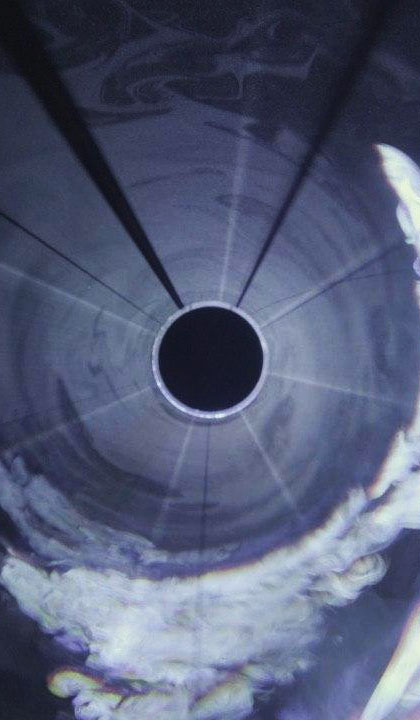


PARMEGIANI
ベルナール・パルメジャーニ
La Creation du Monde
This is a sprawling, ambitious painting in sound modeled on the birth of the universe. Moving from roiling, gaseous clouds of hiss and static through sharp peels of detailed, unrestrained texture, this is acousmatic music at its very finest, literally creating a universe of sound out of thin air.

UJOO LIMHEEYOUNG
Machine Tree
Machine with Tree is a kinetic sculpture combining dead trees with metal machinery. It is designed to use the object’s center of gravity to achieve a movement where the tree appears to float in midair. In Machine with Tree, a dead tree is placed at the end of a long, sharp rod on the machine. The tree slowly moves back and forth with the machine’s movements, as though floating in midair. Through its creation of artificial, bizarre movements controlled by machinery, it illustrates a melancholy contemplation of the strange and contradictory things woven together by our reality.

SETUP
Tube
S E T U P is a stage design and lighting design international studio founded by Znamensky Dmitry, Novikov Stepan and Zmunchila Pavel. The studio works in the field between contemporary art, lighting design and programming with a mission to explore the expressive opportunities provided by new digital technologies. S E T U P aims to create installations and multimedia works that can sharpen the physical perception of the environment and help explore more possibilities of image manipulation. Our creative product is high-tech multimedia work, concepts and laser installations. Our studio is open for experiments and is ready to cooperate with various artists to find the right visual interpretations for their work.

MALIN BÜLOW
Elastic Bonding
Bülow’s performative installations draw attention to the body and in particular the skin. With next to clinical sharpness she seeks to touch upon the relational painspots around our existence. She works together with dancers that become activators and holders of her elastic, sensi-claustrophobic interventions.

Eve Bailey
Rising Awareness
Could one succeed in rising the level of awareness by sharpening one’s perception rather than repeating the vapid catchphrase, “raising awareness,” which has been coopted by an ever-growing money-raising industry that fails to improve our circumstances in a substantive way? Wearing a cocktail dress, I assembled a large kinetic structure made of wooden beams and ladders in front of the audience. I then walked and balanced on the twenty-foot wide structure at eight feet off the floor. Rising Awareness addresses my ongoing preoccupations about the physicality of experience, inhabiting the body, proprioception as the possible strongest sense of self, how spatial awareness correlates with overall awareness and self-awareness, how physicality enhances creativity, finding balance between gravity and groundlessness, a concept of happiness as the fullest expression of one’s particular cognitive potential, pushing boundaries, and the current irreverent politics of liability.

Roman Vlasov
concept 47
Vlasov’s striking conceptual architecture hits upon contemporary’s most important design features: sharpness, elegance, simplicity, and sleekness. The juxtaposition between nature and the rigidity of a man-made structure accentuate the beauty of the construction. Aesthetically beautiful, Vlasov’s work is efficiently displayed from every angle.

alex da corte
Bad Cat
“A giant cat made of foam and tangerine velvet with a wide, cartoonish, sharp-toothed grimace, almost fifteen feet high, is flipped on its back at the center of the gallery. It’s vulnerable—it looks like it’s yowling—and its shadow is a cut-out wraith of blue carpet.” Erin Schwartz.
.
Da Corte often uses surreal imagery and everyday objects in his practice and explores ideas of consumerism, pop culture, mythology, and literature.

ALEXANDER KHOKHLOV
الكسندر خوخلوف
亚历山大·霍赫洛夫
アレクサンダーホフロフ
Александр Хохлов
Alexander Khokhlov decided to disregard a traditional perception of make-up. In his Weird Beauty photo series, made together with a Russian make-up artist Valeryia Kutsan, Alexander uses women’s face as canvas creating sharp black and white patterns.

bridget collins
Manic Botanic
The Brooklyn-based, Minneapolis-born photographer is blessed with a phenomenal combination of acute eye for composition, natural understanding of colour and a terrific sense of narrative and timing that elevates her work beyond that of many of her peers into a world that’s sharp, enchanting and lusciously coloured. There’s not many photographers out there that could hook you in with a shot of a photo in a plastic bag, but in Bridget’s hands this uninspiring subject matter becomes a visual treat.

Erwin Wurm
ארווין וורם
アーウィンウーム
ЭРВИН ВУРМ
Erwin Wurm, one of Austria’s most important and internationally famous sculptors, has been preoccupied with expanding the concept of sculpture since the 1980s. Wurm is primarily a sculptor, and traditional sculptural concerns such as the relationship between object and pedestal, the function of gravity, the fixing of form, and the manipulation of volume, play through all his work.
Increasing, remodeling or removing volume, the habitual interests of many sculptors, are given a new twist in Wurm’s work. Volume and adding volume are treated as sociocrital issues. In 1993, Erwin Wurm wrote an instructional book on how to gain two clothing sizes in eight days. Eight years later, he made his first Fat Car by plumping up an existing car with styrofoam and fiberglass, which resulted in a pitiful, chubby version of the original sportsy model. By taking the question of obesity, Wurm probes the link between power, wealth and body weight. He also wants to offer a sharp criticism of our current value system, as the advertising world demands us to stay thin but to consume more and more.

Ivan Navarro
Reality Show
The artist is known for the union between the neon and fluorescent and socio-political messages. His minimalist and modern sculptures and installations are guided by sharp social and political criticism, which has its origin in the artist personal history – that was born amid the military dictatorship of Augusto Pinochet, in Santiago, in the 1970s. The dictator used to adopt, among other absurd practices, power cut as a way to impose curfews on people. A light to control the masses is a memory of Iván Navarro childhood and eventually became the major subject of his work.


WIM VANDEKEYBUS & ULTIMA VEZ
MENSKE
Even the standing room only tickets have sold out, and the raging mass of disappointed kids looks like they may start a riot: the atmosphere before Ultima Vez’s performance is akin to a rock concert. Choreographer superstar Wim Vandekeybus’s company has toured the world with their trademark vocabulary of acrobatic, extreme, often violent movement, soaked in multimedia and energetic music. Menske (meaning approximately ‘little human’), their latest work, has all the typical flaws and qualities of classic Vandekeybus. On the conservative end of political intervention, Menske is an explosive concoction of brash statements about the state of the world today, a sequence of rapidly revolving scenes of conflicting logic: intimist, blockbuster, desperate, hysterical. The broad impression is not so much of a sociological portrait, but of a very personal anguish being exorcised right in front of us, as if Vandekeybus is constantly switching format in search of eloquence. Visually, it is stunning, filmic: a slum society falling apart through guerrilla warfare, in which girls handily assume the role of living, moving weapons. A woman descends into madness in an oneiric hospital, led by a costumed and masked group sharpening knives in rhythmic unison. A traumatised figure wanders the city ruins dictating a lamenting letter to invisible ‘Pablo.’ Men hoist a woman on a pole her whole body flapping like a flag. “It’s too much!” intrudes a stage hand, “Too much smoke, too much noise, too much everything!” And the scene responsively changes to a quiet soliloquy. At which point, however, does pure mimesis become complicit with the physical and psychological violence it strives to condemn? Unable to find its way out of visual shock, Menske never resolves into anything more than a loud admission of powerlessness.

Alicja Kwade
Die Gesamtheit aller Orte
“It’s easy to trace the curves in Kwade’s perfectly placed bent tubing and piping, but it takes a second to realize that even the installation’s larger, solid objects—a door, a window, mirrors, iron gates, sheets of metal, and even a bicycle—not only travel on her orbits’ paths, but have also been altered (in some cases just barely) to conform to them. The white door’s slight curvature is hardly noticeable until you’re at close range. The imposing rusty gates are generously rounded. There’s an almost imperceptible bend to a door with an oval mirror. A few copper pipes in the outermost rings disappear into the gallery wall; in the very center of the installation, a two-euro coin, propped up on its rim, and a sharply curved sheet of metal face each other, mysteriously.”Kimberly Bradley

SARAH CHILVERS
Sharp Surface

JIRI KYLIAN – STEVE REICH
イリ·キリアン – スティーヴ·ライヒ
יירי קיליאן – סטיב רייך
Иржи Килиана – Стив Райх
Falling Angels
Falling Angels was created in 1989 as one Kylián’s Black and White Ballets. The Black and White ballets consisted of six pieces, with Falling Angel being dance 6. It is choreographed to Steve Reich’s Drumming (Part One) created in 1971, which was based on ceremonial ritual music from Ghana (West Africa). Throughout Fallen Angels there is the use of mesmeric choral movement and repeated phrases. Falling Angels is for 8 women and depicts female dancers in their aim to achieve perfection but succumb in various stages to the human female psyche and female events such as ambition, seduction, pregnancy, birth, death, motherhood and self-awareness. Kylián was influenced by surrealism and minimalism during the creation of this work and the ‘black and white ballets’. In this ballet we see the combination of classical lines and sharp percussive movements that give unpredictability to the piece as a whole